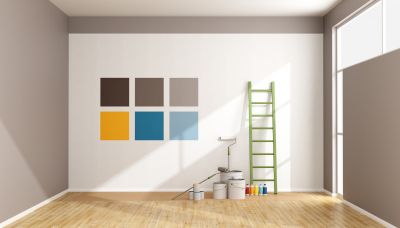Top Products For Interior Paintings To Transform Your Space
Discover essential tools and supplies that help achieve flawless interior paint finishes with ease and professional results.
 Interior painting supplies encompass a wide array of products designed to facilitate the transformation of indoor spaces. From primers and paints to brushes, rollers, and finishing tools, each component plays a vital role in achieving a smooth, durable, and aesthetically pleasing finish. Selecting the right products depends on various factors including surface type, desired finish, and room conditions. High-quality tools and materials can significantly influence the ease of application and the longevity of the paint job.
Interior painting supplies encompass a wide array of products designed to facilitate the transformation of indoor spaces. From primers and paints to brushes, rollers, and finishing tools, each component plays a vital role in achieving a smooth, durable, and aesthetically pleasing finish. Selecting the right products depends on various factors including surface type, desired finish, and room conditions. High-quality tools and materials can significantly influence the ease of application and the longevity of the paint job.
Top Overall Option
Multi-Purpose Interior Painting Kit
A comprehensive kit that includes a variety of brushes, rollers, painter's tape, primer, and finishing tools designed to support a complete interior painting project. Its versatility and range of included items make it suitable for different surfaces and finishes, providing a balanced combination of quality and convenience for DIYers and professionals alike.
Types of Products For Interior Paintings
Interior Wall Primer
Primers prepare surfaces for painting, promoting adhesion and uniform color coverage.
Acrylic Interior Paint
Water-based paints suitable for walls and ceilings, offering ease of cleanup and low odor.
Oil-Based Interior Paint
Durable paints often used for trim and areas requiring extra toughness.
Matte Finish Paint
Provides a non-reflective surface that helps hide imperfections.
Eggshell Finish Paint
Offers a soft sheen, balancing durability and subtle gloss.
Satin Finish Paint
Features a smooth, velvety appearance suitable for high-traffic areas.
Semi-Gloss Paint
Reflective surface ideal for kitchens, bathrooms, and trim.
High-Quality Paint Brushes
Various sizes and shapes designed for detailed work or broad coverage.
Paint Rollers
Different nap lengths for smooth or textured surfaces, aiding efficient coverage.
Painter's Tape
Creates clean lines and protects edges during painting.
Drop Cloths
Protect floors and furniture from paint splatters and drips.
Extension Poles
Help reach high ceilings and large wall areas comfortably.
Edgers and Trim Tools
Assist in achieving precise edges and detailed work.
Paint Sprayers
Provide quick and even coverage for large or textured surfaces.
Touch-Up Pens
Ideal for small repairs and quick touch-ups after painting.
Sandpaper and Abrasives
Prepare surfaces and smooth out imperfections before painting.
Cleaning Solutions
Ensure tools and surfaces are properly cleaned to maintain quality.
Popular Choices
Widely used for preparing walls to enhance paint adhesion.
Commonly selected for its ease of application and quick drying time.
Popular for living rooms and bedrooms due to its subtle sheen.
Favored for their efficiency and ability to handle various textures.
Essential for creating sharp, clean lines and protecting trim.
Commonly used to safeguard floors and furniture during painting.
Preferred for reaching high ceilings and large wall areas.
Chosen for detailed work and finishing touches.
Popular for covering large surfaces quickly and evenly.
Often selected for kitchens and bathrooms due to its durability.
Commonly used in hallways and high-traffic areas.
Convenient for small repairs and quick fixes.
Regularly used for surface preparation and smoothing.
Important for maintaining equipment and ensuring quality results.
When considering interior painting projects, it's important to evaluate the compatibility of paints with different surfaces such as drywall, wood, or plaster. Primers are often used to prepare surfaces, ensuring better adhesion and uniform color. Paints come in various finishes, including matte, eggshell, satin, semi-gloss, and gloss, each offering different visual effects and levels of durability. Proper application tools, like brushes and rollers, help achieve a consistent coat, reduce brush marks, and improve overall appearance.
In addition to basic tools, there are specialized products such as edgers, painter's tape, drop cloths, and extension poles that assist in creating clean lines and protecting surrounding areas. For detailed or intricate work, smaller brushes and fine-tipped tools are recommended. For large surfaces, rollers with different nap lengths can help optimize coverage and texture. Investing in quality products can make a notable difference in the ease of the painting process and the final result, especially for interior projects where appearance and finish quality are paramount.
Key Buying Considerations
- Surface compatibility: Ensure the product is suitable for the material you are painting.
- Finish type: Decide on matte, eggshell, satin, semi-gloss, or gloss based on the desired look and durability.
- Coverage area: Check the product’s coverage per gallon to estimate how much you need.
- Application method: Choose brushes, rollers, or sprayers based on project size and detail level.
- Drying time: Consider how quickly the paint or primer dries to plan your workflow.
- Ease of cleanup: Water-based paints are generally easier to clean up after use.
- Durability requirements: Select products that withstand wear and cleaning in high-traffic areas.
- Color options: Ensure a wide range of colors or custom mixing options are available.
- Tool compatibility: Match brushes and rollers with the type of paint for optimal results.
- Brand reputation: Opt for trusted brands known for consistent quality.
- Price point: Balance quality with budget considerations without compromising essential features.
- Environmental conditions: Consider humidity and temperature which can affect drying and adhesion.
- Preparation needs: Some products require extensive surface prep, while others are more forgiving.
- Safety features: Look for low VOC or odorless options if indoor air quality is a concern.
- Long-term maintenance: Choose products that are easy to touch up or repaint over time.
